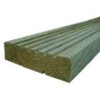Just about to relay part of my line on decking planks that will come into contact with the ground in places,
What is the consensus, do I lay them grooves up which possibly traps water or grooves down which exposes more surface area to dampness from below?
38
What is the consensus, do I lay them grooves up which possibly traps water or grooves down which exposes more surface area to dampness from below?
38

